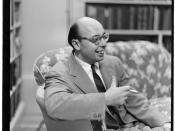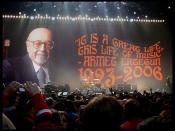Ahmet Ertegun, founder of Atlantic Records and a major force in American music was the son of a prominent Turkish diplomat; he was born in Istanbul and raised in Europe before founding a recording empire with his brother in New York City. Ahmet Ertegun loved rhythm and blues, rock and roll, jump, swing, and every type of jazz. More than anything, he loved the high and low life. When he died at 83 years old, about six weeks after injuring himself in a backstage fall at a Rolling Stones concert, the world lost not only the greatest recording legend who ever lived but also a unique individual whose personal and professional life comprised the history of popular music in America over the past seventy years.
Born in Istanbul on July 31st, 1923, Ahmet Ertegun might never have come to America if the Ottoman Empire had not suffered a crushing defeat.
In 1932, when Ahmet was nine, his older brother took him to see Cab Calloway and Duke Ellington at the London Palladium. Two years later, Ahmet learned his father had been assigned to Washington to serve as TurkeyÃÂs first ambassador to the U.S during President RooseveltÃÂs administration. Expecting to be thrust into an America he had only experienced through music, Ahmet was sent to the Landon School for Boys instead. Even as a child, Ahmet wanted to make records. When he was fourteen, his mother bought him a toy record cutting machine. Taking an instrumental version of West End Blues, he put it on a Magnavox record player, sang lyrics he had written into a microphone, and then amazed his friends by playing it for them without telling them he was singing. In 1946, Somehow, Ahmet persuaded Dr. Vahdi Sabit, a Turkish dentist and also a family friend, to mortgage his home and loan him $10,000 to start his own record label in New York City. In 1947, Atlantic Records was born.
AhmetÃÂs first major signing was the singer Ruth Brown. On her way to New York to perform at the Apollo Theater in October 1948, she was involved in a car accident which broke both her legs. On January 12th, 1949, Ahmet brought her a contract to sign while she was still lying in her bed. Atlantic paid the portion of her hospital bill not covered by insurance.
One Friday during the noon show at the Apollo Theater, Ahmet saw Big Joe Turner, who was already thought to be way past his prime be every other label and had also recently been dropped from Columbia. Ahmet came across Turner after a show one night drowning his sorrows in a nearby bar. Telling Turner he was the greatest blues singer ever, Ahmet said that all he needed was new material and persuaded him to sign with Atlantic. He then wrote ÃÂChains of LoveÃÂ for Turner, which reached number 2 on the charts.
In 1952, Ahmet signed Ray Charles, the artist who would come to define Atlantic. Up to that point, Charles had been playing in the style of Nat King Cole and Charles Brown. Wanting to push Charles toward a grittier sound, Ahmet wrote two songs for him, ÃÂHeartbreakerÃÂ and ÃÂMess Around.ÃÂ Charles suddenly began, ÃÂto play the most incredible example of that style of piano.ÃÂDuring this period, those in charge of Atlantic began to realize that their target audience was no longer rural and black but teenage and white. Up to date blues with a beat and infectious catch phrases and danceable rhythms; it has to have a message. To put it another way, the blues had a baby, and they titled it rock and roll.
Ahmet had first met Sonny Bono through Phil Spector, who had come and gone through Atlantic without producing any major hits. Bono had actually worked as AhmetÃÂs assistant on recording sessions for the Righteous Brothers. When Charlie Greene and Brian Stone, then managing Sonny and Cher, called to say the pair was not happy at Warner Bros., Ahmet signed them to Atlantic In 1965.
Greene and Stone then contacted Atlantic about another band they had found in Los Angeles. The band was Buffalo Springfield.
With the era of the small independent label now officially over, rock & roll was big business. Ahmet was smart enough to understand he would absolutely need corporate money to compete in this new enormous industry; he was able to seduce and then sign the worldÃÂs greatest rock and roll band.
In 1970, the Rolling StonesÃÂ onerous long-term deal with Decca finally expired. In London, Ahmet phoned Jagger to say it was time to sit down and make a deal. Mick replied he would be more than happy to do just that after he spoke to Clive Davis at Columbia. Stunned, Ahmet hung up the phone. As he would later recall, ÃÂWhenever I saw Mick with someone else, my heart sank. It was a painful, ecstatic courtship.ÃÂ Picking the phone back up, Ahmet called Jagger and said that while he completely understood his talking to Clive, he could only sign one major act this year and unless he got an answer in a hurry, it was going to be Paul Revere and the Raiders. Then he hung up. For the next forty-five minutes, the phone rang constantly. Ahmet never picked it up. Not long after, the Rolling Stones joined Atlantic. Landing the Stones confirmed that Atlantic was now the pre-eminent record label in America.
On May 3rd, 1975, Jerry Wexler, feeling as though he was no longer involved in decision making at the label, wrote a letter to Ahmet in which he stated, ÃÂUnder no circumstances, Ahmet, can I be your employee. ThatÃÂs the bottom line.ÃÂ Although Ahmet protested, ÃÂMan, you canÃÂt quit. ItÃÂs unthinkable,ÃÂ the greatest team in the history of the record business split after twenty-two incredible years. In 1978, Wexler complained to New Yorker writer George W.S. Trow that he never saw his old pal anymore, stating, ÃÂAhmet sees only two kinds of people - social people and morons. And I am not either one.ÃÂ Nonetheless, when Wexler wrote his autobiography, Rhythm and the Blues, in 1993, he dedicated the book to Ahmet.
In 1983, after being approached with the idea of doing a television show called ÃÂThe Rock & Roll Hall of Fame,ÃÂ Ahmet contacted Rolling Stone founder and editor Jann Wenner, Jerry Wexler, record executives Bob Krasnow and Seymour Stein, and music-business lawyer Allen Grubman with the idea of actually establishing an institution to honor the greatest artists, producers, and record executives in the field. Going from city to city, they heard a variety of presentations before deciding on Cleveland as the physical home for the building. The first Hall of Fame class; which included Jerry Lee Lewis, James Brown and Chuck Berry; was inducted in 1986. The museum opened nine years later. Ahmet Ertegun himself was inducted into the Hall in 1987. The main exhibition space at the museum bears his name.
At an age when most of the others with whom heÃÂd started in the record business had long since retired, Ahmet was still putting out hits by artists such as Debbie Gibson, Twisted Sister, AC/DC, Rush and Skid Row. When Phil Collins, whom Ahmet considered one of the most impressive artists heÃÂd ever known, played ÃÂIn the Air TonightÃÂ for him for the first time, Ahmet told Collins that if he wanted it to be a single, he would have to put extra drums on it. Unlike so many who made it big in the music business only to cash out by selling the companies they had infused with their own lifeblood, Ahmet held fast. Until the end of his life, he was still in charge of what he had built from the ground up. That he died after falling backstage at a show by a band that he truly loved is an ending too perfect for any self respecting Hollywood screenwriter to have written. A year before he died, Ahmet told an interviewer how heÃÂd like to be remembered: ÃÂI did a little bit to raise the dignity and recognition of the greatness of African-American music.ÃÂAlthough the music business that Ahmet helped create has completely changed, itsÃÂ success still comes down to the quality of a song that people want to hear again so badly that they will happily pay for the privilege. Better than anyone, Ahmet Ertegun understood that need, having experienced it himself from the time he was a child. And while the fabulous manner in which he chose to live caused all those with whom he came into contact to love him madly, the real reason Ahmet will be remembered is because by dedicating his life to rhythm and blues, rock and roll, jump and swing, and every form of jazz, from Ruth Brown, Big Joe Turner and Ray Charles to the Drifters and Bobby Darin to Buffalo Springfield, Cream, Crosby, Stills, Nash and Young, Phil Collins, Tori Amos, Kid Rock, and Gnarls Barkley, Ahmet Ertegun gave people all over the world, many of whom still do not know his name, the soundtrack of their lives.
Works CitedÃÂNet, Glimse. "Ahmet Ertegun - Biography ". 3/26/09 .
ÃÂTribute, Ahmet. "Ahmet Ertegun - Tribute". 3/26/09 .
ÃÂRecords, Atlantic. 3/26/09 .
ÃÂStone, Rolling. "Rolling Stones". 3/26/09 .

![English: Portrait of Ahmet M. Ertegun and Nesuhi Ertegun, Turkish Embassy(?), Washington, D.C., 194-].](https://s.writework.com/uploads/14/145141/english-portrait-ahmet-m-ertegun-and-nesuhi-ertegun-turkish-thumb.jpg)

![[Portrait of Ahmet M. Ertegun and Nesuhi Ertegun, Turkish Embassy(?), Washington, D.C., 194-] (LOC)](https://s.writework.com/uploads/14/145141/portrait-ahmet-m-ertegun-and-nesuhi-ertegun-turkish-embassy-thumb.jpg)
